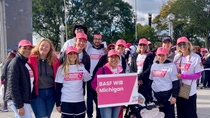Michigan
Wyandotte - North Works
BASF moves forward with long-term environmental remedies at its Wyandotte North Works Site in a way that is protective of people and the environment.
BASF is committed to implementing solutions that benefit the Detroit River and the Down River community. Under the oversight of the U.S. Environmental Protection Agency (EPA) and the Michigan Department of Environment, Great Lakes, and Energy (EGLE), the remedial work at the Site is designed to ensure that contaminated groundwater from the historical activities at the North Works Site (Site) is not impacting the Detroit River. BASF is on schedule to implement additional remedial measures at the Site that are protective of people and the environment.
This website is intended to provide you with updates and address frequently asked questions. We invite you to check back here regularly for the latest information.
There are four environmental projects being conducted under the oversight of the EPA and EGLE: (i) a Groundwater Extraction System designed to control groundwater; (ii) a Perimeter Barrier Project designed to prevent the discharge of impacted groundwater to the Detroit River; (iii) a Perimeter Resin Pilot Test Groundwater Collection System to prevent PFAS in groundwater from historic joint firefighting exercises at the site with the City of Wyandotte from migrating to the Detroit River; and (iv) a sediment removal project to dredge contaminated sediments from the Upper Trenton Channel of the Detroit River.
Groundwater Extraction System
BASF continues to operate a groundwater extraction system installed at the North Works site under a 1986 Consent Decree with EGLE. BASF continues to meet its obligations under the Consent Decree.
Perimeter Barrier Project
EPA and BASF continue to finalize the Perimeter Barrier Project, a comprehensive, long-term groundwater protection measure, which includes constructing a physical barrier/wall along the north, east, and south property boundary of the North Works site. The project is progressing through several design phases with EPA.
In accordance with the regulatory process, this project requires 30%, 60%, 95% and final design submittals. In May 2023, EPA approved the 30% design. BASF submitted the draft for the initial 60% design in March 2024, which the EPA reviewed and approved in November 2024. BASF continues to work closely with the EPA to reach the next milestone, the 95% basis of design.
BASF continues to work closely with EPA and EGLE to minimize the timeline of the project, including by requesting expedited agency review.
Perimeter Resin Pilot Test Groundwater Collection System
In 2023, BASF received approval to operate a Perimeter Resin Pilot Test groundwater collection system to address PFAS in groundwater from historic joint firefighting exercises with the City of Wyandotte. The new system began operating in July 2023 and will be operated until construction of the Perimeter Barrier Project is completed.
Aqueous Film Forming Foam (“AFFF”) fire suppressants containing certain PFAS compounds were used at the Wyandotte site during joint emergency response training events with the Wyandotte Fire Department and Downriver HAZMAT teams from the 1980s through early 2000s. More information can be found here.
As stated by the Michigan PFAS Action Response Team (MPART), “the City of Wyandotte's drinking water intake is immediately downstream of BASF NW [North Works]. Detectable levels of PFOS, and PFHxS were present in a sample collected in August 2019. Ten subsequent sampling events through June 2020 did not identify PFAS at detectable levels in raw or finished drinking water.” See BASF – North Works Wyandotte (Wyandotte, Wayne County). The 2019 detection was subsequently attributed to poor sampling methodology.
Further, the 2022 and 2023 drinking water quality reports from the City of Wyandotte show no detectable levels of pollutants of concern, including mercury, benzene, and PFAS. Since August 2019, sixty-one sampling events have demonstrated no detectable levels of PFAS compounds. (See Wyandotte Water)
Upper Trenton Channel Sediment Removal Project
BASF, Arkema, and Union Carbide (the “Project Partners”) are working to remediate sediments in the Upper Trenton Channel, a 3.25-mile channel of the Detroit River that flows from north to south between Grosse Ile and the Michigan mainland (the "Project Area"). Among the contaminants of concern in the Project Area are high pH, VOCs, SVOCs, metals, and NAPL (non aqueous-phase liquid), some of which EPA believes relate to historic operations and discharges of various industrial users along the Detroit River.
EPA's Great Lakes National Program Office (GLNPO) leads the project, and funds a portion of the costs for engineering design and then remediation of the Project Area using funding from the Great Lakes Legacy Act.
The goal is to dredge over 200,000 cubic yards of impacted sediments along the shoreline.
More information can be found hereATSDR Human Health Assessment for Downriver Community
On November 19, 2024, the Michigan Department of Health and Human Services (MDHHS) announced that the Agency for Toxic Substances and Disease Registry (ATSDR) had accepted a petition for a public health assessment related to the BASF Wyandotte site. MDHHS, as the cooperative agreement partner, will be responsible for conducting this public health assessment.
BASF was made aware of the public health assessment, but has not been contacted by MDHHS or ATSDR. BASF believes that any assessment needs to be based on sound science and accurately applied.
BASF coordinates with all local, state and federal regulatory agencies to ensure our sites operate within all mandated environmental guidelines and reporting requirements. Consistent with our commitment to the Responsible Care program, the company proactively employs comprehensive safety and environmental protective measures in our operations.
Our responsibility is to provide safe operations and products for our employees and customers while protecting our communities and the environment. We regard protection of health, safety and the environment as our most important responsibility.
